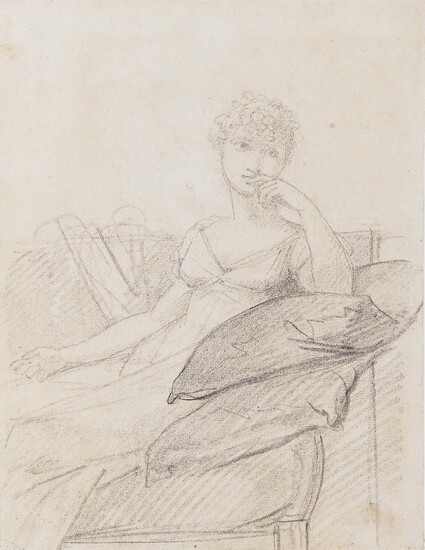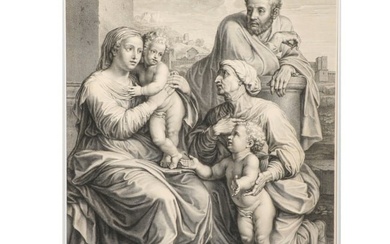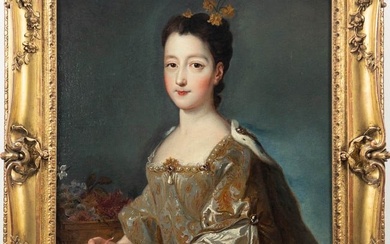François (François-Pascal-Simon) Baron Gérard - Studie zum Bildnis einer jungen Dame
François (François-Pascal-Simon) Baron Gérard
1770 Rome - 1837 Paris, ascribed
"Study for a portrait of a young lady"
Three-quarter figure, sitting to the left. The left hand is held to the face. Graphite on paper. 27,2 x 21 cm. Mounted. Rest.
The motif of the informal, casually seated lady, half reclining and holding only the upper part of her body upright, runs as a topos through art around 1800. Representations such as Antonio Canovas marble sculpture of Paolina Bonaparte as "Venus Victrix" (1808), of unbroken fame up to our time, or Jacques-Louis Davids "Madame Recamier" (1800) should be mentioned here as representative. There is no longer any sign of the stiff self-dramatisation or smugly erotic charisma of the portraits of the preceding period. The artists of the 1800s take us into the private (est) environment of the ladies, sitting in their salon and lost in thought. An artistic retreat into privacy, away from the everyday life of a politically turbulent time full of social upheaval. Even Joséphine de Beauharnais, Napoleons beautiful and much-loved wife, later Empress of the French, had herself portrayed in such a position on her divan by François Baron Gérard in 1801. In a delicate, flowing Empire dress, she sits with her feet stretched out and gracefully crossed on a thick and soft cushion, her right arm resting casually on the back cushion. She looks at us attentively, full of dignity and yet allowing the viewer into her private life. The (still) unknown young lady in our drawing is depicted in a similar situation. Two voluminous cushions support her left elbow, her right arm rests gently on the cushion. With her legs cut, probably in a similar position to Joséphines, she gazes pensively past the viewer - lost in thought. For stylistic reasons, this drawing can be attributed to the same artist who so unmistakably captured Joséphine de Beauharnais on canvas: François Baron Gérard. The latter was a student of Jacques-Louis David from 1786 and soon became his favourite pupil. From 1793, he worked as an executive painter in Davids studio. Gérards unusual talent as a portrait painter was soon to become apparent; even in comparison with the portraits of his teacher, the artist was soon able to assert himself with his modernity and quality. Several commissions he received from Napoleon and his family in the first decade of the 19th century brought about the decisive turning point in Gérards career. He produced his best and most famous works, crowned by the iconic portrait Napoléon en habit impérial (Napoleon in Coronation Regalia), of which almost 20 versions are known today. From then on, the artist received a steady stream of commissions from France and abroad. Napoleons favour was also beyond measure; as early as 1803 Gérard was made a knight of the Légion dhonneur, and he also became Premier peintre Joséphines. The present drawing was also made during this period, which established François Gérards fame. We are grateful to Jean-Marie Le Fell, Paris, who supports an attribution of the drawing to Gérard on the basis of a photograph.
Provenance: Private collection France. - Private collection Berlin.
.schlagwort { color: #999; } .schlagwort:hover { text-decoration: none; }
Estimate
Time, Location
Auction House
François (François-Pascal-Simon) Baron Gérard
1770 Rome - 1837 Paris, ascribed
"Study for a portrait of a young lady"
Three-quarter figure, sitting to the left. The left hand is held to the face. Graphite on paper. 27,2 x 21 cm. Mounted. Rest.
The motif of the informal, casually seated lady, half reclining and holding only the upper part of her body upright, runs as a topos through art around 1800. Representations such as Antonio Canovas marble sculpture of Paolina Bonaparte as "Venus Victrix" (1808), of unbroken fame up to our time, or Jacques-Louis Davids "Madame Recamier" (1800) should be mentioned here as representative. There is no longer any sign of the stiff self-dramatisation or smugly erotic charisma of the portraits of the preceding period. The artists of the 1800s take us into the private (est) environment of the ladies, sitting in their salon and lost in thought. An artistic retreat into privacy, away from the everyday life of a politically turbulent time full of social upheaval. Even Joséphine de Beauharnais, Napoleons beautiful and much-loved wife, later Empress of the French, had herself portrayed in such a position on her divan by François Baron Gérard in 1801. In a delicate, flowing Empire dress, she sits with her feet stretched out and gracefully crossed on a thick and soft cushion, her right arm resting casually on the back cushion. She looks at us attentively, full of dignity and yet allowing the viewer into her private life. The (still) unknown young lady in our drawing is depicted in a similar situation. Two voluminous cushions support her left elbow, her right arm rests gently on the cushion. With her legs cut, probably in a similar position to Joséphines, she gazes pensively past the viewer - lost in thought. For stylistic reasons, this drawing can be attributed to the same artist who so unmistakably captured Joséphine de Beauharnais on canvas: François Baron Gérard. The latter was a student of Jacques-Louis David from 1786 and soon became his favourite pupil. From 1793, he worked as an executive painter in Davids studio. Gérards unusual talent as a portrait painter was soon to become apparent; even in comparison with the portraits of his teacher, the artist was soon able to assert himself with his modernity and quality. Several commissions he received from Napoleon and his family in the first decade of the 19th century brought about the decisive turning point in Gérards career. He produced his best and most famous works, crowned by the iconic portrait Napoléon en habit impérial (Napoleon in Coronation Regalia), of which almost 20 versions are known today. From then on, the artist received a steady stream of commissions from France and abroad. Napoleons favour was also beyond measure; as early as 1803 Gérard was made a knight of the Légion dhonneur, and he also became Premier peintre Joséphines. The present drawing was also made during this period, which established François Gérards fame. We are grateful to Jean-Marie Le Fell, Paris, who supports an attribution of the drawing to Gérard on the basis of a photograph.
Provenance: Private collection France. - Private collection Berlin.
.schlagwort { color: #999; } .schlagwort:hover { text-decoration: none; }







